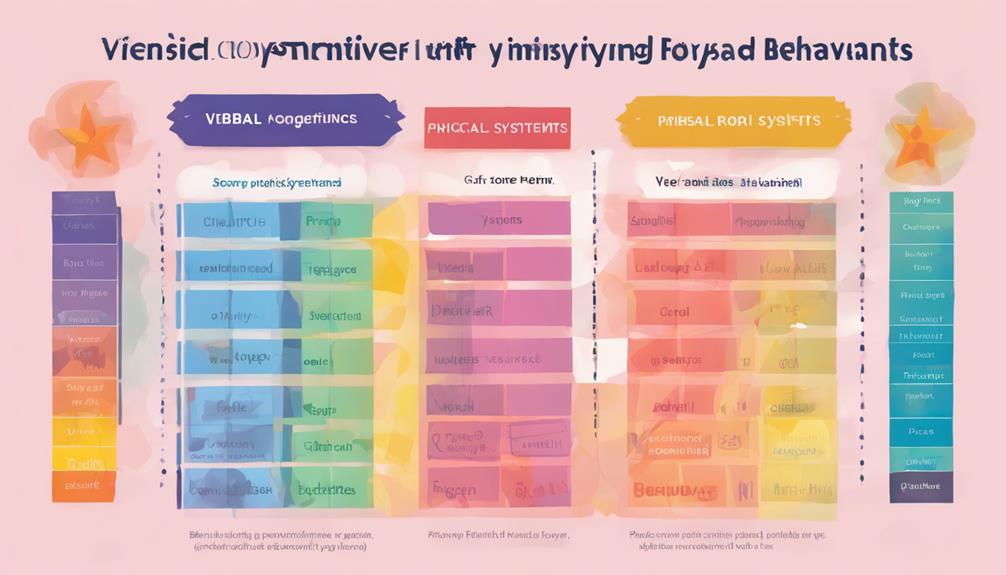To master reward systems for sissy behavior improvement, blend immediate and delayed rewards. Set clear behavior goals using SMART criteria. Implement positive reinforcement techniques consistently for sustained change. Track progress meticulously to adjust rewards effectively. Guarantee fairness and consistency in rewarding behavior to maintain motivation. This strategic approach, supported by data-driven research, enhances behavior modification outcomes notably.
Types of Reward Systems

Different varieties of reward systems can be classified based on their structure and method of reinforcement. Reward types play a vital role in shaping behavior patterns and motivation.
One key aspect to take into account is the timing of the rewards. Timing refers to when the reward is given in relation to the desired behavior.
Immediate rewards, such as praise or small incentives, are effective in reinforcing behavior promptly. This type of reward is particularly advantageous for shaping new behaviors or maintaining consistent performance.
On the other hand, delayed rewards, like monthly bonuses or long-term incentives, can help sustain motivation over time and encourage more intricate behavior patterns.
Understanding the impact of reward types and timing on behavior is essential for designing an effective reward system. By aligning rewards with desired behaviors and adjusting the timing based on the specific goals, you can create a system that maximizes motivation and drives continuous improvement.
Setting Clear Behavior Goals
Setting clear behavior goals is vital for guiding individuals towards desired outcomes and providing a framework for performance evaluation. Goal setting allows individuals to define specific objectives they aim to achieve, offering a clear direction for behavior improvement. When setting behavior goals, it's important to make sure they're specific, measurable, achievable, relevant, and time-bound (SMART). Monitoring behavior against these SMART goals enables individuals to track progress and make adjustments as needed to stay on course.
Effective goal setting in behavior improvement involves breaking down larger objectives into smaller, manageable steps. This approach provides a roadmap for individuals to follow, making progress more tangible and achievable. Additionally, setting clear behavior goals helps in aligning efforts with desired outcomes, increasing motivation and focus on the tasks at hand.
Behavior monitoring is a key component of goal setting, as it allows individuals to assess their progress objectively. By continuously tracking behavior against established goals, individuals can identify areas for improvement and celebrate successes along the way. This data-driven approach to behavior goals not only enhances accountability but also provides valuable insights into the effectiveness of behavior improvement strategies.
Implementing Positive Reinforcement Techniques
Consistently applying positive reinforcement techniques is essential for shaping desired behaviors effectively and reinforcing behavior improvement efforts. Behavior modification relies heavily on the use of positive reinforcement to encourage the repetition of specific behaviors. By providing rewards such as praise, treats, or privileges immediately following the display of the desired behavior, individuals are more likely to continue exhibiting that behavior in the future. Positive reinforcement creates a clear link between the action and its consequences, increasing the likelihood of desired behaviors being repeated over time.
Research has shown that positive reinforcement is a powerful tool in behavior modification. Studies indicate that individuals who receive positive reinforcement are more motivated to engage in the desired behavior consistently. This method not only increases the frequency of the desired behavior but also helps in sustaining behavior change in the long run.
Tracking Progress and Adjusting Rewards
Tracking progress and adjusting rewards plays a vital role in optimizing the effectiveness of behavior modification strategies. Reward tracking involves systematically recording the behaviors exhibited by the individual and the corresponding rewards given. This data-driven approach allows for an objective evaluation of the sissy's progress over time.
By analyzing these records, you can identify patterns, trends, and areas that may require further attention or reinforcement.
Adjustment strategies are essential for fine-tuning the reward system to ensure maximum impact. If certain rewards seem to lose their effectiveness or if the sissy shows a plateau in progress, it may be time to adjust the types or frequency of rewards.
For instance, you could introduce new, more enticing rewards or change the criteria for earning them. Regularly reviewing and adapting the reward system based on the observed progress is necessary for maintaining motivation and driving sustained behavioral improvements.
Ensuring Consistency and Fairness

To maintain the integrity of the behavior modification process, it's necessary to make sure that the reward system operates consistently and fairly. Consistency in rewarding sissy behavior improvement is vital as it establishes clear expectations for the individual undergoing the behavior modification program. By consistently rewarding desired behaviors, you reinforce the connection between the action and the reward, increasing the likelihood of its repetition.
Inconsistency can lead to confusion and diminish the effectiveness of the reward system, potentially hindering progress.
Fairness is equally important in ensuring the success of the behavior modification process. Fairness involves treating all participants equally and impartially, regardless of individual differences. It's necessary to establish clear criteria for earning rewards and apply them consistently to all individuals involved in the program.
Fairness promotes a sense of equity and motivates participants to actively engage in sissy behavior improvement.
Frequently Asked Questions
Can Rewards Be Personalized Based on Individual Sissy Preferences?
Yes, rewards can indeed be personalized based on individual sissy preferences. By offering customized incentives tailored to specific likes and motivations, you can effectively enhance behavior improvement and engagement in the learning process.
Is It Necessary to Involve a Professional for Reward System Design?
You don't need a professional to design reward systems. DIY options are viable with online resources. Research and creativity can help tailor rewards to individual preferences effectively. Utilize available tools for a personalized approach to motivate behavior change.
How Do You Handle Setbacks in Behavior Improvement With Rewards?
When handling setbacks in behavior improvement with rewards, remember to adapt your approach. Stay motivated by focusing on progress rather than perfection. Overcoming obstacles requires patience and encouragement. Keep adjusting your reward system to enhance effectiveness.
Should Rewards Be Monetary or Non-Monetary for Sissy Behavior?
When deciding between monetary and non-monetary rewards for sissy behavior, consider the value of gifts versus experiences and recognition versus material items. Each approach can motivate differently based on individual preferences and desired outcomes.
What if Sissy Behavior Improvement Stagnates Despite Reward Systems?
If sissy behavior improvement stagnates despite reward systems, reevaluate strategies. Seek guidance for trying new approaches. Address underlying issues to foster growth. Adapt and evolve methods to effectively encourage positive changes in behavior.
Conclusion
To sum up, mastering reward systems for sissy behavior improvement requires setting clear goals, implementing positive reinforcement techniques, and tracking progress effectively.
By ensuring consistency and fairness in the reward system, sissies can be motivated to improve their behavior and achieve their desired outcomes.
By utilizing these strategies, individuals can create a structured and effective system to support sissy behavior improvement over time.